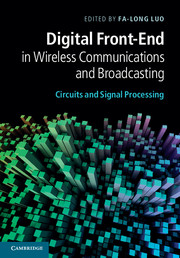Book contents
- Frontmatter
- Contents
- Contributors
- Preface
- Part I Introduction to digital front-end
- 1 Introduction to wireless communications and digital broadcasting
- 2 Basic principles and protocols of digital wireless communications
- 3 Digital front-end and system overview in wireless communication
- 4 System overview and front-end technologies in digital broadcasting
- 5 Digital front-end for multiple standards and multimode compatibility
- Part II DPD and CFR
- Part III DUC, DDC, ADC, DAC, and NCO
- Part IV Digital calibration, imbalance compensation, and error corrections
- Part V Circuits and system integration in digital front-end
- Index
- References
4 - System overview and front-end technologies in digital broadcasting
from Part I - Introduction to digital front-end
Published online by Cambridge University Press: 07 October 2011
- Frontmatter
- Contents
- Contributors
- Preface
- Part I Introduction to digital front-end
- 1 Introduction to wireless communications and digital broadcasting
- 2 Basic principles and protocols of digital wireless communications
- 3 Digital front-end and system overview in wireless communication
- 4 System overview and front-end technologies in digital broadcasting
- 5 Digital front-end for multiple standards and multimode compatibility
- Part II DPD and CFR
- Part III DUC, DDC, ADC, DAC, and NCO
- Part IV Digital calibration, imbalance compensation, and error corrections
- Part V Circuits and system integration in digital front-end
- Index
- References
Summary
Introduction
The first International standard for Terrestrial Broadcasting of Digital Television was published by the Advanced Television System Committee (ATSC) in 1995. The standard is known as ATSC and was adopted by the Federal Communications Commission (FCC) in 1996. The main purpose of this standard was the transmission of High Definition Television (HDTV) for home consumption, that is, to deliver the experience of viewing full motion pictures in fixed scenarios with large screens [15]. The modulation scheme selected in ATSC was 8-level Vestigial Sideband (8-VSB) that contrasts with the Coded Orthogonal Frequency Division Multiplexing (COFDM) scheme selected by the European Digital Video Broadcasting – Terrestrial (DVB-T) and Japanese Integrated Services Digital Broadcasting – Terrestrial (ISDB-T) standards. Since any terrestrial TV system has to overcome many channel impairments and interferences (ghosts, noise bursts, fading, etc.) to reach the home viewer, the selection of the RF modulation format is crucial.
The selection of 8-VSB modulation in Digital Television ATSC system was motivated by different reasons. First, 8-VSB can cover larger distances with fewer repeaters than COFDM, which supposes a considerable cost reduction for low population North America rural areas. Direct Broadcast Satellite (DBS) Television is not popular in North America and therefore rural areas had to be covered by terrestrial television.
- Type
- Chapter
- Information
- Digital Front-End in Wireless Communications and BroadcastingCircuits and Signal Processing, pp. 98 - 119Publisher: Cambridge University PressPrint publication year: 2011



